Greetings, BugFans,
The BugLady has been having too much fun recently, taking pictures, so she dusted off this episode from November, 2012 and added some new words and new pictures.
For years, the BugLady has been amassing shots of big, showy orbweaver spiders in the spider family Araneidae (Charlotte’s relatives), aka the Garden spiders. She knows that “picture-keying” has its limits, and that there’s a lot of variability within spider species (these are all Marbled orb weavers), https://bugguide.net/node/view/1618434/bgimage, https://bugguide.net/node/view/1905479/bgimage, https://bugguide.net/node/view/1304801/bgimage, https://bugguide.net/node/view/1302073/bgimage, https://bugguide.net/node/view/1273874/bgimage, https://bugguide.net/node/view/1166829/bgimage, https://bugguide.net/node/view/718340/bgimage, and that real scientists use microscopes, so she has her fingers crossed about IDs. If she were smart, she would be satisfied just to get the genus right. Bugguide.net has a lot of helpful images, and so does Spiders of the North Woods by Larry Weber.
FYI, in the course of her research, she has seen the name spelled orb weaver, orb-weaver, and orbweaver.
Orbweavers have been practicing their craft for some 140 million years now (full disclosure – there are some non-orbweavers that weave orb-type webs, and a few orbweavers that don’t). With more than 3,500 kinds of Araneidae worldwide (180 north of Mexico), they account for about a quarter of spider species. They can be found in any habitat where there’s something to hitch a web to, but some species prefer woodlands, wetlands, etc.
Although orbweavers have eight eyes (two rows of four, and the middle four form a trapezoid), their vision is not so good. Their legs are adorned with bristles/spines and have an extra claw on each foot (that third claw helps them to manipulate silk as they spin it and to traverse the non-sticky parts of the web). They range in size (body length) from ¼” to an inch-plus; females are often considerably bigger than males and have large spherical abdomens. Some species are nocturnal, and others are diurnal.
Building a web is an amazing feat that involves sending a sticky line out into the breezes. If it catches on something, the spider forms the “spokes” of the wheel with non-sticky web and then uses sticky silk for the spiral. It takes about an hour. For a more comprehensive explanation of the process, see https://www.smithsonianmag.com/smithsonian-institution/ask-smithsonian-how-do-spiders-make-webs-180957426/. Many nocturnal orbweavers eat their dewy web in the morning and rebuild it each night. Males tend to be nomadic and are not avid web-makers.
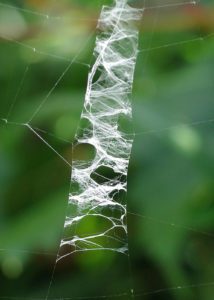
Some (but not all) orbweavers, especially in the genus Argiope, weave a heavy “zipper” or other pattern called a stabilimentum into part of the web. Guesses about the function of the stabilimentum are that it strengthens the web, that it allows the spider to control the tension of the strands in the web, that it gives birds a “visual” and bats an “echo” that keeps them from flying through the web, that it attracts insects by reflecting UV light, that it keeps insects from flying into the web when the spider is satiated, that it makes the rest of the web seem less conspicuous/more invisible by comparison, and that it provides a camouflaged spot for spiders to hang (head down) in the web’s center. Not all stabilimentum look like zippers https://bugguide.net/node/view/4805, https://bugguide.net/node/view/123319 (the BugLady loves the Florida Argiope Superhero spider throwing lightning).
Orbweavers will often tackle prey that is larger than they are if it gets snagged in their web. They first paralyze it with a toxic bite, then wrap it, and later eat it. The front two pairs of legs handle the prey while the rear two pairs manipulate the silk. If the prey is a stinging or venomous critter, it’s “wrap first; bite later.” They tenderize it with fluid from their mouth, and then re-ingest their digestive juices as they eat the softened prey.
Males are not avid web-makers, but for many species a web is part of the courtship ritual. He may meet her on her web, taking care not to behave like prey (he is, after all, making her trap web vibrate) or he may spin a line (mating thread) and hang next to her web. He typically dies after mating, even if he doesn’t inadvertently provide her with a protein meal.
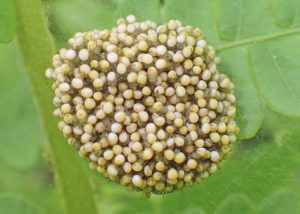
In the species shown here, Mom places from several hundred to a thousand eggs in one or more spherical egg cases/cocoons that are hung from the web or hidden in tree bark or in some other crevice (that’s what those nuthatches are looking for in winter). She guards them until she is, inevitably, killed by the cold (“And no one was with her when she died.” Charlotte’s Web).
The eggs of some species don’t hatch until spring hatch, and others hatch and make their way out of the case before winter, but it’s more common for the spiderlings to hatch and remain within the egg sac throughout winter, feeding on the yolk inside (and eventually on each other), to be called from their egg sac and balloon away in the warm air of spring. These beauties have been around for the full spider season, it’s just that they start small and don’t get big enough to be noticeable until mid-summer/early fall. They’re large and dramatic, and they have the right equipment to bite you, but an orbweaver’s favorite strategy is avoidance. They’re not aggressive, but if you insist on man-handling one, it will respond appropriately.
Without further ado:
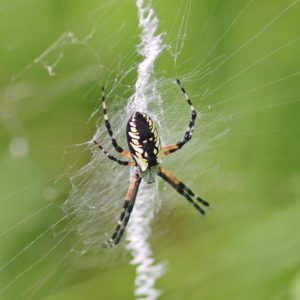
The BLACK AND YELLOW ARGIOPE/GARDEN SPIDER (Argiope aurantia) is a familiar, large (a female’s body may measure an inch-plus) spider that dwells in sunny grasslands, edges, gardens, wetlands and suburbs. Wikipedia says its Latin name means “gilded silver-face.” The thick zigzag stabilimentum woven into the web has given Argiopes the nickname “writing spiders.” Webs are generally built/repaired at night, and a Black and yellow argiope will use a productive web site over and over. Black and yellow argiope numbers have fallen dramatically and inexplicably in the BugLady’s fields in the past decade-plus.
The female makes several egg cases in fall and attaches them to the sides of the web (safe from ants, but not from birds and parasitic wasps, and not, apparently, from a bevy of inquilines (borders) either; researchers have monitored Black and yellow argiope egg cases and tallied 19 species of insects and 11 species of spider that have emerged from them).
Males are nomadic, looking for romance, but they will make a small web when they find a female. They court by plucking the female’s web (settle down, folks – the BugLady means this literally), hoping she can differentiate suitor from prey.
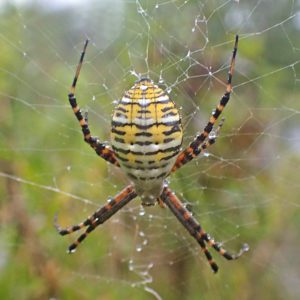
BANDED GARDEN SPIDERS (Argiope trifasciata) have become more common in the fields as the Black and yellow argiope numbers have dwindled – Nature does abhor a vacuum. Studies suggest that the webs of Banded garden spiders (and those of other diurnal orbweavers) tend to be oriented east-west, and that the position of the occupant in the center of the north side of the web, “belly” facing south, maximizes her exposure to solar heating. Although they are as large as those of the Black and yellow argiope, the webs of Banded garden spiders may lack a stabilimentum.
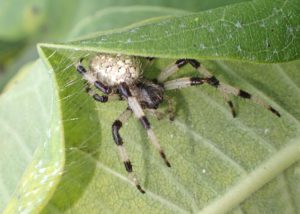
The SHAMROCK ORBWEAVER (Araneus trifolium), is also called the Pumpkin spider. One source compared the spider’s plump abdomen to the shape of a pumpkin; another attributed the name to the fact that Shamrock orbweavers are out and about around Halloween. The family Araneidae is the third-largest spider family worldwide, and the genus Araneus is the largest spider genus, with 1,500 species known globally.
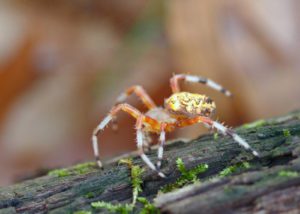
The BugLady has seen MARBLED ORBWEAVERS (Araneus marmoreus) on the forest floor on distinctly cool days into early November, pushing the limits of cold-bloodedness. Adults spin a web and then wait, concealed in a silken hiding place, monitoring vibrations via a “signal strand” attached to the web. When an insect gets caught in the web, the Marbled orbweaver will “process” it and carry it to its hiding place to eat it.
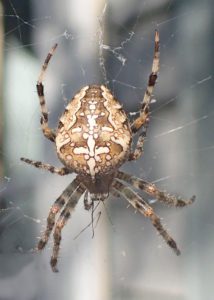
The CROSS ORBWEAVER (Araneus diadematus) is a non-native spider who, like the Bridge spider of previous BOTW fame, immigrated to our shores from Europe (it’s also called the European garden spider and the Diadem spider). Like the bridge spider, it likes to hang out on buildings, especially on walls with exterior lights https://uwm.edu/field-station/cross-orbweaver-spider/.
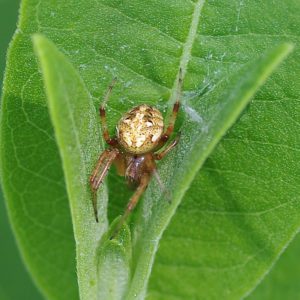
The BugLady is calling this shy creature an ARABESQUE ORBWEAVER (Neoscona arabesca) because of the pairs of slanted, dark lines on the abdomen. Spiders in the genus Neoscona are called “Spotted Orb Weavers.” According to bugguide.net, the Arabesque orbweaver “stays in a retreat (usually a curled up leaf) to the side of the web during the day. At night it rests in the center of the web with the tip of the abdomen pushed through the open space in the center of the web.”
Aren’t these spiders fine!!
Here’s an article about spiders in an age of declining insect populations: https://www.theguardian.com/commentisfree/2021/aug/16/the-guardian-view-on-spiders-season-of-the-web.
Kate Redmond, The BugLady
Bug of the Week archives:
http://uwm.edu/field-station/category/bug-of-the-week/
